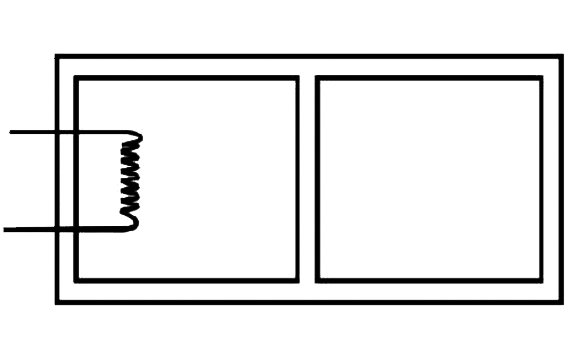A bimetallic strip of thickness d and length L is clamped at one end at temperature t1. Find the radius of curvature of the strip if it consists of two different metals of expansivity α1 and α2(α1>α2) when its temperature rises to t2∘C.Solution in Gujrati
The correct Answer is:d(α1−α2)(t2−t1)
Here : (R+d2)ϕ=L(1+α1ΔT)…..)i)
(R−d2)ϕ=L(1+α2ΔT)…(ii)
⇒R=d[1+(α1+α22)ΔT](α1−α2)ΔT
Since (α1+α22)ΔT<<1
=d(α1−α)ΔT=d(α1−α2)(t2−t1)
_E01_242_S01.png)
Topper's Solved these Questions
- GEOMETRICAL OPTICSBOOK - ALLEN CHAPTER - GEOMETRICAL OPTICSEXERCISE - EXERCISE - 04 (B)
15 Videos
- GEOMETRICAL OPTICSBOOK - ALLEN CHAPTER - GEOMETRICAL OPTICSEXERCISE - EXERCISE - 05 (A)
73 Videos
- GEOMETRICAL OPTICSBOOK - ALLEN CHAPTER - GEOMETRICAL OPTICSEXERCISE - Comprehension Based Questions
66 Videos
- CURRENT ELECTRICITYBOOK - ALLEN CHAPTER - CURRENT ELECTRICITYEXERCISE - EX.II
66 Videos
- GRAVITATIONBOOK - ALLEN CHAPTER - GRAVITATIONEXERCISE - EXERCISE 4
9 Videos
Similar Questions
The rectangular box shown in Fig has partition which can slide without friction along the length of the box. Initially each of the two chambers of the box has one mole of a mono-atomic ideal gas (λ=5/3) at a pressure P0, volume V0 and temperature T0. The chamber on the left is slowly heated by an electric heater. The walls of the box and the lead wires of the heater is negligible. The gas in the left chamber expands pushing the partition until the final pressure in both chambers becomes 243P0/32. Determine (i) the final temperature of the gas in each chamber and (ii) the work done by the gas in the right chamber.

View SolutionAn aluminium sphere of 20cm diameter is heated from 0∘C to 100∘C. Its volume changes by (given that the coefficient of linear expanison for aluminium (αAl=23×10−6/0C)
View SolutionA certain amount of ice is supplied heat at a constant rate for 7 min. For the first one minute the temperature rises uniformly with time. Then it remains constant for the next 4 min and again the temperature rises at uniform rate for the last 2 min. Given Sice=0.5cal/g∘C,Lf=80cal/g.
The initial temperature of ice is
View SolutionIn the Bohr's model of hy drogen atom, the electron moves around the nucleus in a circular orbit of radius 5×10−11m. Its time period is 1.5×10−16s. The current associated with the electron motion is:-
View SolutionAssertion : The difference in the value of acceleration due to gravity at pole and equator is proportional to square of angular velocity of earth.
Reason : the value of acceleration due to gravity is minimum at the equator and maximum at the pole.
View SolutionObtain a general relationship between temperature coefficient of resistance α1 and α2 at temperature T1.∘C and T2.∘C for a given conductor.
View SolutionTwo metal strips, each of length l and thickness d at temperature T0 are riveted together so that their ends coincide. One strip is made of metal A having a linear coefficient αB where αA>αB . When this bimetallic-strip is heated to a temperature (T0+ΔT) , one strip becomes longer than the other and the bimetallic strip bends into an arc of a circle. What is the radius of curvature R of the strip ?
View SolutionTwo straight metallic strips each of thickness t and length l are rivetted together. Their coefficients of linear expansions are alpha_(1) "and" alpha_(2) . If they are heated through temperature DeltaT , the bimetallic strip will bend to form an arc of radius
View SolutionTwo mettalic strips each of length l_(0) and thickness d , temperature T_(0) are riveted together so that their ends coincide. One strip is maxe of a metal of coeficient of expansioin alpha_(1) and the other of a metal with a coefficient alpha_(2) , where alpha_(2)gtalpha_(1) . When this bimetallic strip is heated to a temperature T_(0)+DeltaT , find the radius of curvature R of the strip.
View SolutionWhen a strip made or iron (alpha_(1)) and copper (alpha_(2)),(alpha_(2) gt alpha_(1)) is heated
View SolutionA bimetallic is made of two strips A and B having coefficients of linear expansion alpha_(4) and alpha_(B) . If alpha_(A) lt alpha_(B) , then on heating, the strip will
View SolutionWhen the two rods having expansion cofficient alpha_(1), alpha_(2) (alpha_(2) gt alpha_(1)) and width d are heated then the radius of the rod after expansion. R=(d)/((alpha_(2)-alpha_(1))Delta T)
View SolutionA bimetalic strip is made of two strips A and B, having co-efficeint of linear expansion as αA and αB. If αA>αB which of the following describes the behavior fo the metallic strip when heated?
View SolutionA bimetalis strip conists of two metakl strips with diffesrent coefficients of linear expansion alpha_(1) and alpha_(2) each of small thickness d and length L_(0) at T_(0) . They are bonded together and, with a change in temperature DeltAT , will curve in a circular arc, as shown in figure. Show that the radius of curvature R is given approximately be R=d/((alpha_(2)-alpha_(1))DeltaT)
View SolutionTwo metal plates of length l0 and width x are joined together at temperature t by rivetting them in such a way that the edges of the plates coincide. The coefficients of linear expansion of the materials of the plates are α1 and α2(α1>α2). When the bimetallic strip is heated to (t+δt) it bends and forms an arc of a circle. Find the radius of curvature of the strip.
View SolutionA bimetallic strip is formed out of identical strips one of copper and the other of brass. The coefficients of linear expansion of the two metals are alpha_(c) " and " alpha_(B). On heating the temperature of the strip goes up by DeltaT and the strip bends to form an arc of radius of curvature R. Then R is
View Solution
